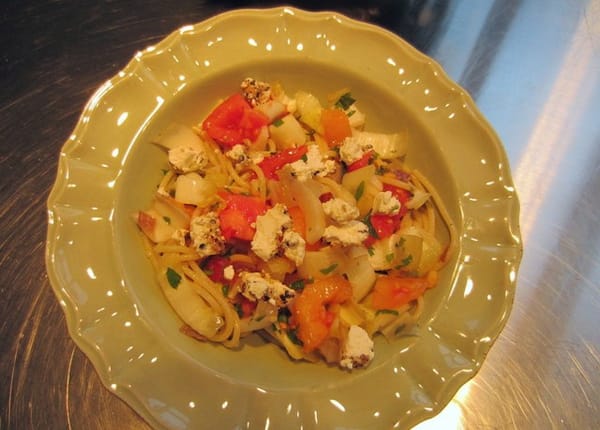Recipe: Pasta For The Planet
Pamela Osborne's own pasta recipe uses the partial remains in your fridge — good for your palate, pocketbook and the planet.

Pamela Osborne's own pasta recipe uses the partial remains in your fridge — good for your palate, pocketbook and the planet.

Feeling poor? Me too.
Food waste, you may know, is a big problem. Too many of our refrigerators are overloaded with leftover tail-ends of this and that, which are allowed to lounge around, not earning their keep, until they finally give it up and shrivel in the cold dark, starved for attention and unappreciated. This must stop!
I always buy and cook too much for dinners and holidays (my mother grew up on a farm in a big family, boy was she a bad example re calculating amounts), so I always have leftovers. Actually, a case can be made that leftovers are, in fact, one of the rewards of running a kitchen. But what to do with the partial remains? The sole potato, the few stalks of celery? I really hate to throw any food away. Have you seen what’s going on in Venezuela, and Ukraine, and elsewhere? Not good. This can get to be a very expensive habit, too, for us and for the planet. Some invention, and some knowledge of how to assemble things to good advantage, is called for. There aren’t any shortcuts, there are some things only experience and practice can teach you. Maybe these inflationary times can be an incentive to develop the skills needed to make the best use of the food you have bought, the money you spent on it, and the gas you used to travel to buy it. Not to mention the cost of production in the first place.
Anyway, last summer I put together a meal from what seemed an unpromising group of tag-ends and, to my surprise, it was really good. So much better than I expected, in fact, that I later bought the same ingredients so that I could make it again. It was a popular success too, although, I’m not going to lie, it was better with the end-of-summer heirloom tomatoes than with winter’s Campari tomatoes. No surprise there, I guess, but it was still good, and unusual. It never would have crossed my mind to add raw endive to pasta, which this recipe does, even though I’ve often thrown in a handful or two of spinach. A very serendipitous result.
By the way, the endive “hearts” are what was left after the larger outer leaves had been peeled away and used to serve smoked salmon pate. (I gave a recipe for this earlier.) To continue about the endive, when the leaves are used as described, eventually they get to be too small to serve as vehicles. If you don’t have leftover endive, admittedly a long shot, just buy whole heads and use them.

These amounts are what was in my refrigerator. You can, obviously, adjust them proportionally. This will make around three servings, or four more modest ones.
Pasta For The Planet
1/4 of a large purple onion, chopped
2 garlic cloves, pressed
3 endive hearts, sliced crosswise into 1/2” strips. I bought two heads for the reprise. Always discard the first circle of leaves, which have most likely been handled, and not by you.
2 large tomatoes, peeled and chopped. I had one red and one yellow, the last ones of the summer. Five or six Campari tomatoes, skinned (dip briefly into boiling water, remove immediately, the peel will slip off easily), or smaller multi-colored grape tomatoes, can be substituted. But do make this again with summer tomatoes.
1/2 cup, more or less, flat-leafed Italian parsley, chopped
1/2 cup, more or less, chopped chives
Hot pepper oil, or hot pepper flakes. I like the oil.
Extra virgin olive oil
3/4 pound spaghetti or linguini. Buy only semolina pasta extruded through bronze dies, made in Italy.
Vermont brand goat cheese, coated with seeds, cut into small chunks. Do this while the cheese is cold. Do this ahead, let it sit on the counter to warm while you proceed.
In a deep, wide skillet or pan, saute the onion over medium heat until tender, in a few tablespoons of olive oil. Turn down the heat, push the onion aside, and pour in a little more oil. Add the garlic and let the oil bubble up through it. Turn off the heat or move the pan to a cold burner if you have an electric stove. Do not brown the garlic, or it will be bitter.
Cook the pasta. When just about done, dip out a cup of the pasta water. Quickly drain the pasta and add it to the skillet. Move fast, you want the pasta to be hot.
Mix the pasta with the onions and garlic in your skillet. If it has cooled too much — it should be warm — heat it again briefly before adding the pasta. Mix in the endive, tomatoes, and herbs. Tongs are good for this job, I think. If the mix seems too dry, add a bit of the reserved pasta water and some more oil. Do this very gradually, until the consistency looks right — shiny, unctuous, but not wet or dripping when some is lifted.
Serve immediately in heated bowls, with the pieces of goat cheese added on top. If the pasta is still hot, which it should be, the cheese will soften. Have bread on the side, along with flaked sea salt (Maldon), a pepper mill, and hot oil or hot pepper flakes.